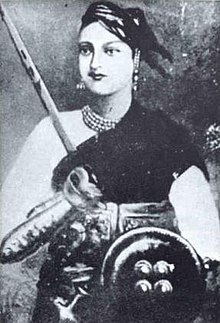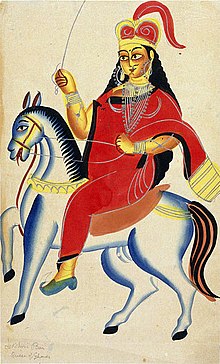Rani of Jhansi
| Rani of Jhansi | |
|---|---|
| Rani of Jhansi | |
 The Rani attired in war gear | |
| Predecessor | Rani Rama Bai |
| Successor | British Raj |
| Born | Manikarnika 19 November 1835[citation needed] Kashi, Varanasi, India |
| Died | 17 June 1858 Gwalior, India |
| Spouse | Jhansi Naresh Maharaj Gangadhar Rao Newalkar |
| House | |
| Occupation | Queen, General |
Lakshmi Bai, the Rani of Jhansi (c.19 November 1835[citation needed] – 17 June 1858) (Marathi- झाशीची राणी लक्ष्मीबाई) was the queen of the Maratha-ruled princely state of Jhansi, situated in the northern part of India. She was one of the leading figures of the Indian Rebellion of 1857 and a symbol of resistance to the rule of the British East India Company in the subcontinent.
Early life
Originally named Manikarnika and nicknamed Manu, Lakshmibai was born at Kashi (Varanasi)[1] to Moropant Tambe and Bhagirathibai Tambe, a Maharashtrian Karhade Brahmin[citation needed] couple. She lost her mother at the age of four. Her father worked at the Peshwa court of Bithoor; the Peshwa brought her up like his own daughter, and called her "Chhabili" for her light-heartedness. She was educated at home.
Because of her father's influence at court, Lakshmibai had more independence than most women, who were normally restricted to the zenana. She studied self-defence, horsemanship, archery, and even formed her own army out of her female friends at court. Tatya Tope, who would later come to her rescue during the 1857 Rebellion, was her mentor.
Lakshmibai was married to Raja Gangadhar Rao Newalkar, the Maharaja of Jhansi, in 1842, and thus became the queen of Jhansi. After their marriage, she was given the name Lakshmibai. The Raja was very affectionate towards her. She[2] gave birth to a son, Damodar Rao, in 1851. However, the child died when he was about four months old. After the death of their son, the Raja and Rani of Jhansi adopted Anand Rao. Anand Rao was the son of Gangadhar Rao's cousin, and was later renamed as Damodar Rao. However, it is said that the Raja of Jhansi never recovered from his son's death, and he died on 21 November 1853.
Because Damodar Rao was adopted, the British East India Company, under Governor-General Lord Dalhousie, applied the Doctrine of Lapse, rejecting Rao's claim to the throne and annexing the state to its territories. In March 1854, Lakshmibai was given a pension of 60,000 rupees and ordered to leave the palace and the Jhansi fort.
The 1857 Rebellion

On May 10, 1857 the Indian Rebellion started in Meerut. This began after the rumour that the new bullet casings for the Enfield rifles were coated with pork and beef fat and unrest began to spread throughout India. During this chaotic time, the British were forced to focus their attentions elsewhere, and Lakshmibai was essentially left to rule Jhansi alone, leading her troops swiftly and efficiently to quell skirmishes initiated by local princes. With the city relatively calm and peaceful in the midst of the unrest in northern India, she conducted the Haldi Kumkum ceremony with great pomp and ceremony before all the women of Jhansi to provide assurance to her subjects and to convince them that the city was under no threat of an attack.[3]
Up to this point, Lakshmibai had been hesitant to rebel against the British, and there is still some controversy over her role in the massacre of Company officials, their wives and children on 8 June 1857 at Jokhan Bagh. This was done to reduce her popularity amongst the countrymen and villagers.[4] Her hesitation finally ended when British troops arrived under Sir Hugh Rose and laid siege to Jhansi on 23 March 1858. An army of 20,000, headed by Tatya Tope, was sent to relieve Jhansi but failed to do so when his forces engaged with the British on 31 March. Along with Sir Hugh Rose there was an Indian deserter who gave ideas to reduce the days of people inside fort[citation needed]. Three days later the besiegers were able to breach the walls and capture the city. The Rani escaped by night with her son, surrounded by her guards, many of them women.[4]

Along with the young Anand Rao, the Rani decamped to Kalpi along with her troops, where she joined other rebel forces, including those of Tatya Tope. The two moved on to Gwalior, where the combined rebel forces defeated the army of the Maharaja of Gwalior after his armies deserted the rebel forces. They then occupied a strategic fort at Gwalior. However, on 17 June 1858,[5] while battling in full warrior regalia against the 8th (King's Royal Irish) Hussars in Kotah-ki Serai near the Phool Bagh area of Gwalior, she was killed and someone burnt her[citation needed]. The British captured Gwalior three days later. In the British report of the battle, General Sir Hugh Rose was reported badly hurt[citation needed] and he commented that the Rani was "remarkable for her beauty, cleverness and perseverance" and had been "the most dangerous of all the rebel leaders".[6]
However, the lack of a corpse to be convincingly identified as that of Lakshmibai convinced Captain Rheese that she had not actually perished in the battle for Gwalior, stating publicly that: "[the] Queen of Jhansi is alive!".[7] It is believed her funeral was arranged on the same day near the spot where she was wounded. Lakshmibai was memorialized in bronze statues at Jhansi and Gwalior, both of which portray her on horseback. Other equestrian statues can be seen in Agra and Pune.
Her father, Moropant Tambey, was captured and hanged a few days after the fall of Jhansi. Her adopted son, Damodar Rao (formerly known as Anand Rao), fled with his mother's aides. Rao was later given a pension by the British Raj and cared for, although he never received his inheritance. Damodar Rao settled down in the city of Indore, and spent most of his life trying to convince the British to restore some of his rights. He and his descendants took on the last name Jhansiwale. He died on 28 May 1906, at the age of 58 years.
In fiction
- Flashman in the Great Game by George MacDonald Fraser, a historical fiction novel about the Indian Revolt describing several meetings between Flashman and the Rani.
- La femme sacrée, in French, by Michel de Grèce. A novel based on the Rani of Jhansi's life in which the author imagines an affair between the Rani and an English lawyer.
- Rani, a 2007 novel in English by Jaishree Misra.
In films and television series
- The Tiger and the Flame (1953), one of the first technicolor films released in India, was directed and produced by Indian filmmaker Sohrab Modi.
- Jhansi Ki Rani (TV series) a television serial aired by Zee TV in which Kratika Sengar plays the role of the rani.
- The Rebel is a new film by Ketan Mehta, and is a companion piece to his film Mangal Pandey: The Rising. The screenplay is by Farrukh Dhondy from a story by Chandra Prakash Dwivedi.
Historical studies
- The Queen of Jhansi, by Mahasweta Devi (translated by Sagaree and Mandira Sengupta). This book is a reconstruction of the life of Rani Lakshmi Bai from extensive research of both historical documents (collected mostly by G.C. Tambe, grandson of the Queen) and folk tales, poetry and oral tradition; the original in Bengali was published in 1956. ISBN 81-7046-175-8
See also
- Central India Campaign (1858)
- Indian Rebellion of 1857
- Company rule in India
- Jhalkari Bai
- Subhadra Kumari Chauhan
- Nana Sahib
- Tatya Tope
- Bithoor
- Mangal Pandey
References
- ^ http://www.copsey-family.org/~allenc/lakshmibai/early.html
- ^ "Jhansi Lakshmi Bai".
- ^ David E Jones, Women Warriors: a History (Brassey’s, 2005), 46.
- ^ a b Rani of Jhansi, Rebel against will by Rainer Jerosch, published by Aakar Books 2007, chapters 5 and 6
- ^ http://www.copsey-family.org/~allenc/lakshmibai/smith-gwalior.html
- ^ David, Saul (2003), The Indian Mutiny: 1857, Penguin, London p367
- ^ Ashcroft, Nigel(2009), Queen of Jhansi, hollywood publishing ltd, Mumbai p.1
Maza Pravas: 1857 cya Bandaci Hakikat (marathi "My journey: the truth about the 1857 rebellion") by Vishnu Bhatt Godse. Amar Balidani by Janki Sharan Verma Zila Vikas Pustika, 1996–97, Jhansi Meyer, Karl E. and Shareen Blair Brysac. Tournament of Shadows Washington D.C.: Counterpoint, 1999.
